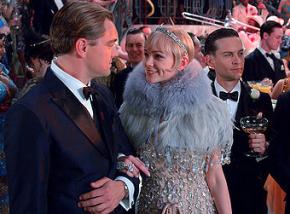Glitz, glitter and Gatsby
The new silver-screen adaption of The Great Gatsby, directed by Baz Luhrmann, misses the nuance of F. Scott Fitzgerald's novel, says .
AS A student at Princeton University, F. Scott Fitzgerald discovered Fabian Socialism by reading up on the political views of H.G. Wells and George Bernard Shaw. In his first novel, This Side of Paradise, protagonist Amory Blaine exhibits contempt for the poor, but says he wants to become a "militant socialist." As early as 1924, Fitzgerald was describing himself as a "communist," even while he attempted to climb the social ladder of New York City.
Though he came from a respectable southern family, Fitzgerald was not rich. He called himself with some exaggeration a "poor boy in a rich boy's world." He also described himself as a racial outcast to his generally WASPish milieu:
I am half black Irish and half old American stock with the usual exaggerated ancestral pretensions. The black Irish half of the family had the money and looked down upon the Maryland side of the family, who had, and really had, that certain series of reticences and obligations that go under the poor old shattered word "breeding" (modern form of "inhibitions"). So...I developed a two-cylinder inferiority complex.

In his 1925 novel The Great Gatsby, Fitzgerald projected some of these personal conflicts onto his characters. Nick Carraway, the young, upward climbing Wall Street trader who narrates the story, feels he is both an "insider" and "outsider" to the world of lavish wealth and consumption that surrounds him in West Egg on Long Island.
The excess is best symbolized by the lifestyle of his preposterously wealthy and mysterious neighbor Jay Gatsby. Gatsby himself is part Fitzgerald: he is newly rich, but from low stock. His parents are described as "shiftless and unsuccessful farm people." Gatsby feels a lingering "inferiority complex" among the blueblood minions he seeks desperately to impress.
As a writer, social critic and a lay student of socialism, what Fitzgerald got most right about the scene of mid-1920s bourgeois New York was its commodity fetishism. The novel is a catalogue and shopping list of the objects Gatsby surrounds himself with which render him mystifying and alluring to onlookers: "blue gardens" in which "men and girls came went like moths among the whisperings and the champagne and the stars;" a Rolls Royce; "five crates of oranges and lemons from a fruiterer in New York;" "spiced baked hams crowded against salads of harlequin designs and pastry pigs and turkeys bewitched to a dark gold."
These bright shiny objects cocoon Gatsby and his party guests: "For a while these reveries provided an outlet for his imagination, they were a satisfactory hint of the unreality of reality, a promise that the rock of the world was founded securely on a fairy's wing."
YET THE Great Gatsby has never translated well to the screen. This was true of the disastrous 1974 Hollywood film starring Robert Redford as Gatsby and Mia Farrow as his unrequited lover Daisy Buchanan. It is also true of Baz Luhrmann's new version currently playing in theaters. Why?
Luhrmann, like many readers of the book, places an excess of sympathy onto the rich and ruling class, while failing to appreciate Fitzgerald's intensely ironic ambivalence and hostility towards them. The first half hour of the film is an orgiastic, highly orchestrated spree of parties at Gatsby's home. The film becomes a commercial for the very thing Fitzgerald (and Karl Marx) were trying to show was toxic about capitalism: its uncritical wonderment towards consumption.
The film squanders credibility needed to capture the caustic irony of Fitzgerald's description of a weeping Daisy overcome by Gatsby's new shirts, or the tragedy of Daisy's own predicament as the property of two hedonistic men: Gatsby and her husband Tom Buchanan.
The film also succumbs to a mildly reactionary distortion of the novel in representing the poor and working class. In the book, Gatsby is murdered by George Wilson, an auto mechanic, after he and Daisy run over his wife Myrtle in Gatsby's screaming yellow roadster. The novel tamely suggests that this is a class comeuppance.
In the film, Wilson's killing of Gatsby is rendered as the melodramatic final break in Gatsby's unrequited love for Daisy. In a scene that could have come out of another sentimental class melodrama, Titanic, Gatsby, played by Leonardo DiCaprio, dies with the name of his lover on his lips.
The film also dishes up crude racial images that go beyond the mild Negrophobia and anti-Semitism of Fitzgerald's novel. The "jazz age" tenor is represented by images of Black people blowing trumpets and grinding in the margins of the frame. A taste for racial primitivism was for sure a part of 1920s U.S. culture, (see for example white people's view of the Harlem Renaissance), but Luhrmann had a chance to update and improve on this.
Instead, we get a soundtrack with Jay Z, Beyoncé and Andre 3000 pegged to faux hip-hop scenes that seem intended to associate "bling" with capitalist excess. Luhrmann does Black people no justice and misses an opportunity to make Fitzgerald's criticism of capitalism more relevant to the racism and economic injustices of our times.
Despite its shortcomings, the new Great Gatsby is worth a look. Fitzgerald was the lyric poet of the decline of America's first modern aristocracy. His swan song for ruling-class morality never gets old.


